Best Living Christmas Trees
Buying a living Christmas tree may or may not be a good idea, depending on the species of tree, among other things. Just because a tree has roots and seems to be growing well at a nursery doesn’t guarantee its long-term success in Texas. Let’s examine some facts.
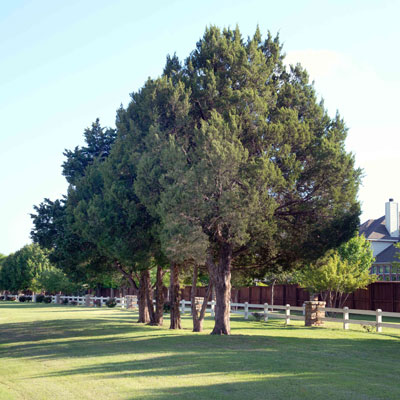
Photo: Row of eastern redcedars shows their inherent conical growth form.
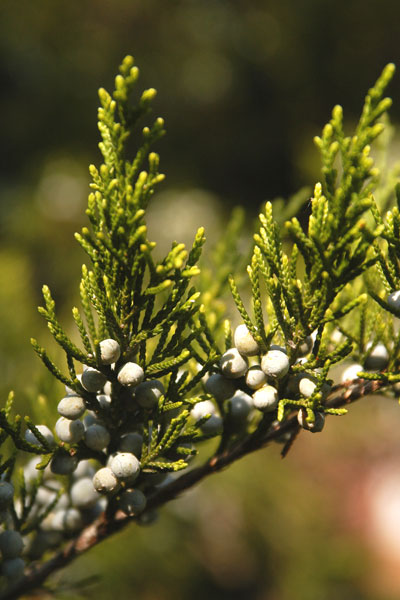
Photo: Cones of eastern redcedar are fleshy, attractive to birds.
• Be sure it’s adapted to our soils and our climate. More on that later, but I wanted to mention it first and foremost.
• Living Christmas trees, depending on the species, often grow to be full-sized evergreen trees 30 to 40 feet tall and almost as wide. Be sure it’s going to be a match for the space you have in your landscape.
• University research has shown that living Christmas trees’ rate of survival following planting is inversely proportionate to the number of days a tree stays indoors. Ideally, you’ll not have it inside more than 10 or 12 days. Warm, dry and dark indoor conditions just don’t bode well for evergreens. Keep it as cool as you can (away from hot drafts, the fireplace, etc.) and moist. Leave it outside as long as you can.
Which types are best?
OK. Here comes the list. They may surprise you, but I’m giving you my suggestions based on years of experience. Your local nurseryman can advise you for your specific part of the state.

Photo: Oakland holly is one of best living Christmas trees for Texas. While not a typical conifer, it’s one of our finest landscaping shrubs.
• Hollies. Nellie R. Stevens, Willowleaf and Oakland hollies trained in pyramidal form are the most dependable. Of all the types, Oakland hollies are the most commonly found trained in Christmas-tree size and shape. In alkaline soils along and west of I-35 you’d probably be best off to avoid Savannah, Foster, East Palatka and all American holly hybrids. Those plants all need acidic soils and high humidity.
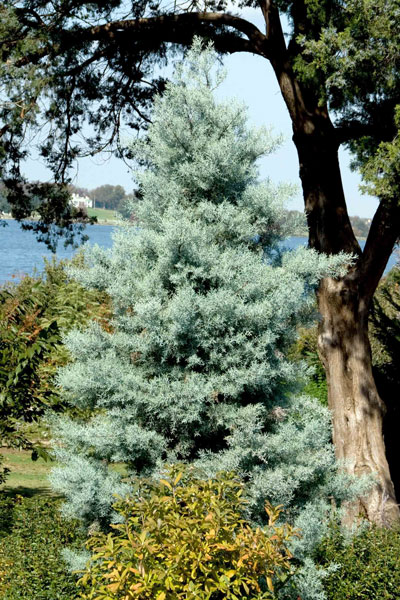
Photo: A “blue” selection of Arizona cypress is soft-textured and colorful in the landscape.
• Arizona cypress. We’ve grown this soft-textured southwestern native for decades, and through that time, it’s gone almost overlooked for use at this season. Buy one of the grafted “blue” types for the best color. It must have good drainage and ample room (35 feet tall and 30 feet wide).
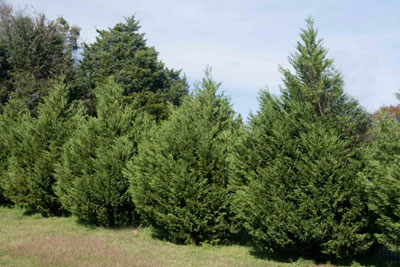
Photo: Eastern redcedars (rear) are large native conifers that are well suited to almost all of Texas. Leyland cypress (foreground) were handsome trees for many years, but they succumbed to the fatal Seiridium canker in 2011. It is a very poor choice.
• Eastern redcedar and other native junipers. These are well suited to Texas conditions. Know the type’s mature size before you buy it. Make sure you have the space it will require. Your nurseryman can advise you. These are by far the most dependable conifers for big parts of Texas, but their problem is that they’re prickly to work around and they’re intolerant of low humidity indoors. Beware of Blue Point, Spartan and a few other types that have known disease problems. Talk to your nursery professional.
Three special types…
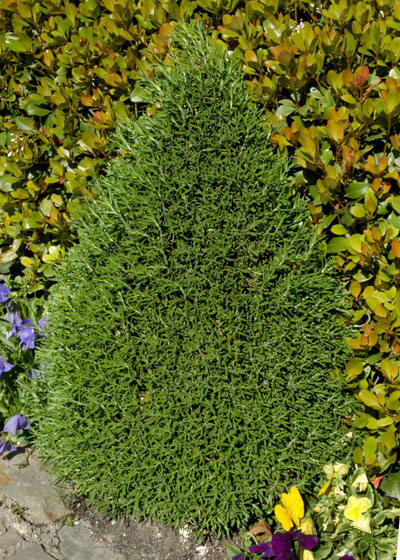
Photo: Rosemary topiary can be set into the landscape after its use as a tabletop Christmas tree.
• Trimmed rosemary. This wonderful herb grows quite well in Texas conditions. (Winter-hardy in the southern two-thirds of the state.) You’ll find it sold, perhaps even pre-decorated with bows and balls, as trimmed little tabletop trees. They’re great plants, and they can certainly be set out into herb beds in the landscape, but it’s difficult to maintain that shape from one year to the next. If you choose to buy one, plant it into the landscape after the holidays, and let it grow on its own.
• Norfolk Island pine. This is a fabulous tabletop Christmas tree, with its gracefully arching branches and its soft-textured needles. If you have really bright light, you can even grow it as a potted tropical – for a while. But it grows to 60 feet tall (and taller), and there’s no way to trim it or to grow it outdoors unless you’re in the tropics, so be prepared to discard it eventually.
• Alberta spruce. This dwarf conifer makes a wonderful tabletop tree, but it won’t take Texas heat. Use it like you would a long-lasting flower arrangement. When it begins to wither in the heat, allow yourself the liberty of discarding it.
Troubled Trees…
You’ll find several other types of living Christmas trees offered in local gardening centers. These have proven to be poor landscaping investments.
• Eldarica (also referred to as Afghan, or Mondell) pines were introduced into the United States landscaping industry 40 years ago. They made all the sense: they were native to arid areas of Afghanistan, so they had to be tolerant of drought. But, they’ve cropped up with fatal and incurable disease issues we didn’t anticipate, and they can’t handle waterlogged soils when it does rain in Texas. They’re not good choices.
• Colorado blue spruces aren’t either. There’s a reason they’re named for that mountainous state, where they can thrive at 8,000 feet and 80-degree summer days. They’ll live for a while here, but they won’t be happy, and neither will you.
• Leyland cypress is worst of them all. It looked great when we first planted it into Texas landscapes 40 or 45 years ago. However, we all saw the devastation that Seiridium canker did to the once-lovely conifer in the Great Summer of 2011. They were toasted, and there was no control for the disease. Add them to the “never-again” list for your landscape.
